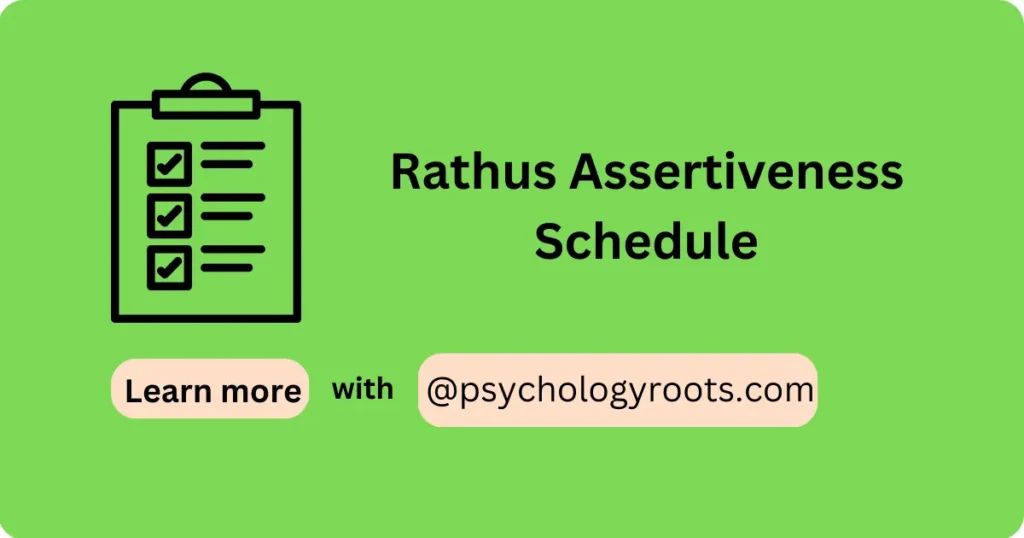Table of Contents
Rathus Assertiveness Schedule
Here in this post, we are sharing the “Rathus Assertiveness Schedule”. You can read psychometric and Author information. We have thousands of Scales and questionnaires in our collection (See Scales and Questionnaires). You can demand us any scale and questionnaires related to psychology through our community, and we will provide you with a short time. Keep visiting Psychology Roots.
About Rathus Assertiveness Schedule
Scale Name
Rathus Assertiveness Schedule
Author Details
Spencer A. Rathus
Translation Availability
Not Sure

Background/Description
The RAS, developed by Spencer A. Rathus in 1973, is a widely used tool for measuring assertiveness. Its development was driven by the need for a more reliable and comprehensive measure compared to existing tools considered outdated at the time.
Here’s a breakdown of the RAS’s background and introduction:
Development:
Rathus drew inspiration from various sources:
- Wolpe and Lazarus’s (1966) work on behavioral therapy situations
- Items from existing assertiveness scales by Allport (1928) and Guilford & Zimmerman (1956)
- Diaries kept by college students
- He aimed to create a scale that addressed multiple aspects of assertiveness, not just specific situations.
Key Features:
- Self-report inventory: Individuals rate how well statements describe them on a 7-point Likert scale (1 = not at all characteristic, 7 = very much characteristic).
- 30 items: Cover various aspects of assertiveness, including expressing needs, saying no, setting boundaries, giving/receiving compliments, and handling criticism.
- Scoring: Simple sum of responses, with higher scores indicating greater assertiveness.
Applications:
- Widely used in research to investigate assertiveness and its correlates.
- Employed in clinical settings to assess assertiveness before and after interventions (e.g., assertiveness training).
- Can help individuals gain self-awareness about their assertiveness level and identify areas for improvement.
Strengths:
- Reliable and valid: Numerous studies support its accuracy in measuring assertiveness.
- Easy to administer and score: Makes it accessible for diverse settings.
- Comprehensive: Covers multiple facets of assertiveness.
Limitations:
- Self-reported measures can be susceptible to bias.
- Limited cultural sensitivity might require adaptations for specific populations.
Administration, Scoring and Interpretation
- Introduce the RAS: Briefly explain the purpose of the assessment and assure confidentiality.
- Provide instructions: Clearly explain how to answer each item, emphasizing the meaning of the Likert scale (1 = not at all characteristic, 7 = very much characteristic).
- Allow questions: Answer any questions about the items or the scale to ensure understanding.
- Administer the RAS: Participants complete the questionnaire independently without interruptions.
Reliability and Validity
The RAS has been extensively evaluated for both reliability and validity, making it a valuable tool for measuring assertiveness. Here’s a breakdown of its key characteristics:
- Internal consistency: Studies have reported Cronbach’s alpha coefficients ranging from 0.77 to 0.82, indicating strong internal consistency, meaning the items measure a single construct (assertiveness) effectively.
- Test-retest reliability: Scores have shown moderate to high stability over time, with correlations around 0.73 over a two-month period. This suggests the measure is consistent and not easily influenced by temporary fluctuations.
- Split-half reliability: Dividing the items into two halves and comparing scores has also shown good reliability, further supporting the measure’s consistency.
- Content validity: The items cover a wide range of assertiveness-related behaviors, making the content appear relevant and representative of the construct.
- Concurrent validity: Scores have been shown to correlate with other measures of assertiveness, suggesting the RAS captures similar aspects of the construct.
- Discriminant validity: Scores have been shown to differentiate between groups expected to differ in assertiveness levels, such as clinical and non-clinical populations.
- Predictive validity: Research suggests the RAS can predict future behaviors related to assertiveness, further supporting its validity.
Available Versions
30-Items
Reference
Rathus, S. A. (1973). Rathus assertiveness schedule. Behavior Therapy.
Important Link
Scale File:
Frequently Asked Questions
What is the RAS?
The RAS is a 30-item self-report questionnaire designed to measure an individual’s level of assertiveness. It was developed in 1973 by Spencer A. Rathus and is one of the most widely used measures of assertiveness.
How does it work?
Participants answer each item on a 7-point Likert scale, indicating how well the statement describes them (1 = not at all characteristic, 7 = very much characteristic). Scores are then summed to provide a total score, with higher scores indicating greater assertiveness.
What does it measure?
The RAS covers a wide range of assertiveness-related behaviors, including:
Expressing needs and wants directly
Saying no to unreasonable requests
Setting boundaries
Giving and receiving compliments
Handling criticism
Is it reliable and valid?
Yes, the RAS has been extensively studied and has shown good reliability and validity. This means the scores are consistent and accurately reflect the construct of assertiveness.
Who can use it?
The RAS is typically used by adults in research and clinical settings. However, it is important to consider cultural adaptations for diverse populations and remember it is a self-reported measure susceptible to biases.
Disclaimer
Please note that Psychology Roots does not have the right to grant permission for the use of any psychological scales or assessments listed on its website. To use any scale or assessment, you must obtain permission directly from the author or translator of the tool. Psychology Roots provides information about various tools and their administration procedures, but it is your responsibility to obtain proper permissions before using any scale or assessment. If you need further information about an author’s contact details, please submit a query to the Psychology Roots team.
Help Us Improve This Article
Have you discovered an inaccuracy? We put out great effort to give accurate and scientifically trustworthy information to our readers. Please notify us if you discover any typographical or grammatical errors.
Make a comment. We acknowledge and appreciate your efforts.
If you have any scale or any material related to psychology kindly share it with us at psychologyroots@gmail.com. We help others on behalf of you.